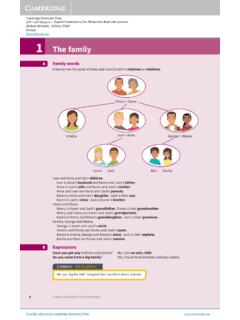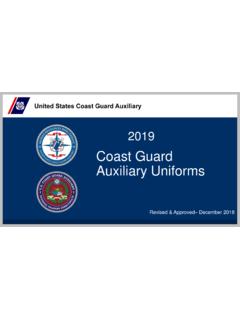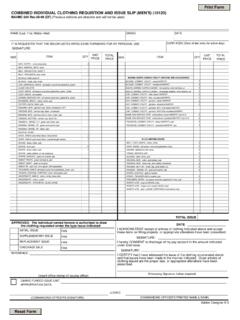Transcription of Modified - Physical Performance Test
1 Modified - Physical Performance Test Testing Protocol: Administer the test as outlined below. Subjects are given up to two chances to complete each item. Assistive devices are permitted for tasks 6 9. 1. Standing Static Balance Feet together: Stand still with your feet together as demonstrated for 10 seconds. Semi Tandem: Stand with the heel of one foot placed to the side of the 1st toe of the opposite foot for 10 seconds. Subject chooses which foot goes forward. Tandem: Stand with the heel of one foot directly in front of the other foot, for 10 seconds. Subject chooses which foot goes forward. 2. Chair Rise: Use a straight back chair with a solid seat that is 16 high.
2 Ask participant to sit on the chair with arms folded across their chest. Stand up and sit down as quickly as possible 5 times, keeping your arms folded across your chest. Stop timing when the participant stands the 5th time. 3. Book Lift: Place a Physician s Desk Reference Book (1988 PDR: lbs) or other heavy book on a table in front of the patient. Ask the patient, when given the command go to place the book, as quickly as they can, on a shelf above shoulder level. Time from the command go until when the book is resting on the shelf. Starting position is with their hands at their side. 4. Put on and remove a jacket: If the subject has a jacket or cardigan sweater, ask them to remove it.
3 If not, give the subject a lab coat. Ask the subject, on the command go to quickly put the coat on completely such that it is straight on their shoulders and then remove the garment completely. Time from the command go until the garment has been completely removed. Hint: it is more accurate to time putting on the garment, then pause (pause the stopwatch), then time taking off the garment. 5. Pick up a penny from floor: Place a penny approximately 12 inches from the patient s foot on the dominant side. Ask the patient, on the command go to pick up the penny from the floor and stand up. This is to be done as quickly as they can; yet allowing for safety and comfort.
4 Time from the command go until the subject is standing erect with a penny in hand. If dexterity is a problem, a pen or similar lightweight object can be used 6. Turn 360 degrees: Ask the subject to turn 360 degrees as quickly as you can, as you feel comfortable and safe . Evaluate using the scale on PPT scoring sheet. Additional data: count the number of steps required. 7. 50-foot walk test: Bring subject to start on a 50 foot walk test course (25 feet out and 25 feet back) and ask the subject, on the command go to walk as quickly as they can to the 25-foot mark and back. Time from the command go until the starting line is crossed on the way back. 8. Stairs: Take vital signs.
5 Bring subject to foot of stairs (nine to 12 steps) and ask subject, on the command go to begin climbing up to a total of 4 flights stairs (as quickly as they can, as they feel comfortable and safe) or until they feel tired and wish to stop. Before beginning this task, alert the subject to the possibility of developing chest pain or shortness of breath and inform the subject to tell you if any of these symptoms occur. You will walk with the subject. Time from the command go until the subjects first foot reaches the top of the first flight of stairs. Go on to record the number of flights (maximum is four) completed (up and down is one flight). Provide a chair for resting when completed, so vital signs can be taken immediately post.
6 Scoring: 32/36 - 36/36 = not frail 25/36 - 31/36 = mild frailty 17/36 - 24/36 = moderate frailty < 17/36 = unlikely to be able to function in the community Brown, M., Sinacore, (2005). Physical and Performance Measures for the identification of mild to moderate frailty. J Gerontol A Biol Sci Med Sci 55:M350-5









